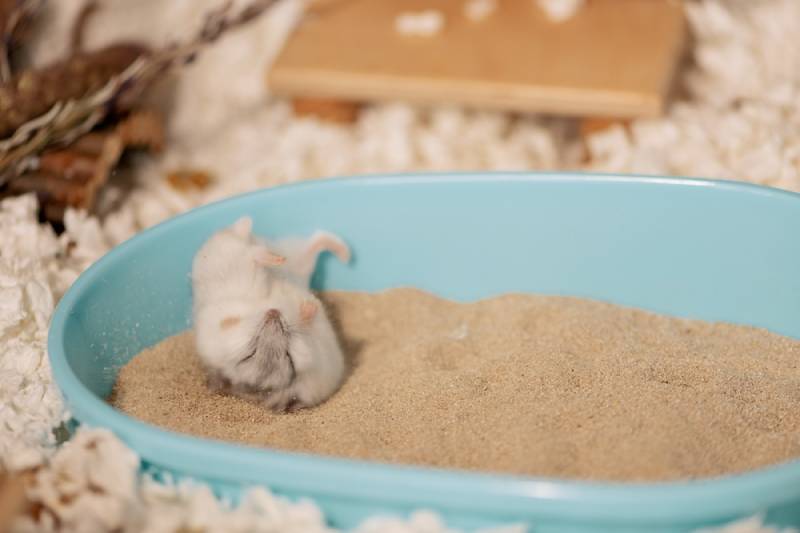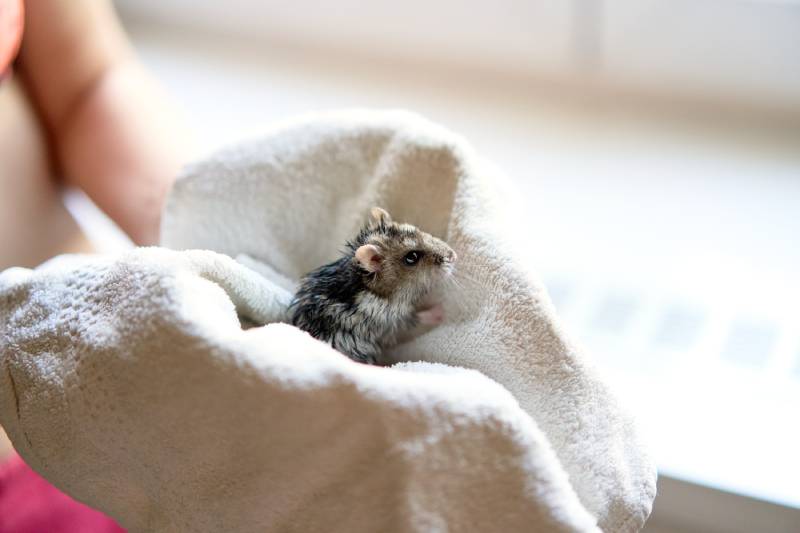How to Give a Hamster a Bath: Vet-Approved Step-by-Step Guide
Updated on

Much like cats, hamsters are notoriously fastidious about cleaning and grooming themselves, and they do the job quite well under most circumstances. You might be wondering: Can you give hamsters a bath? Is it safe or even necessary? Thankfully, no.
Generally speaking, hamsters are low maintenance, and they do not require a bath with water and soap unless they get seriously dirty or have a harmful substance in their fur. Even then, we only recommend bathing them under the specific direction of your vet.
For all these rare occasions, we’ve put together a neat little step-by-step guide on what you’ll need to bathe your hamster safely and get them squeaky clean without disturbing their natural biological balance.
Before You Begin
First, you should know that hamsters are extremely delicate and fragile critters, and they don’t play well with chemical-heavy shampoos like humans use, nor are they used to getting wet. Preferably, you want to use little to no soap at all, but an unscented and hypoallergenic variety is generally best if you must use soap during the bath. Get recommendations from your vet about the best product to use.
Sand is also called for, and you should avoid dust at all costs. Dust particles can pose respiratory risks to your hamster, and that’s not worth it just for a dust bath. Opt for clean, dust-free hamster bathing sand, which should be in any reputable pet store.

You don’t need much to get started here, and the affair should be as quick as possible to avoid shocking your hamster with sudden temperature changes or harming their natural skin and hair oils. Let’s briefly list everything you might need to properly and safely clean your hamster friend today.
- Clean tray
- Sand (not dust)
- Lukewarm water source
- Mild, unscented hamster-friendly shampoo ( ask your vet for recommendations)
- Clean rags—one for drying and one for wetting
Step-by-Step Guide on How to Give a Hamster a Bath
1. Try a Sand Bath First
Hamsters are among the creatures that enjoy an occasional sand bath, which probably just sounds coarse and irritating to you. Supply your hamster with a tray of appropriate bathing sand and they’ll naturally feel the urge to roll around in it. The abrasive properties of the sand rubs dirt and caked-on debris off your hamster’s fur and skin, and it’s 100% natural and safe. You can leave fresh sand for your hamster to regularly bathe in, or if space is an issue, you can present it once a week or so for a quick and cleansing roll in the sand.
2. Physically Remove Any Lingering Debris or Residue
If the sand bath didn’t make a dent in the mess of your hamster’s fur, you may need to get physically involved. If there is something firmly stuck in your hamster’s fur then seek veterinary assistance to remove it. We do not generally recommend using scissors or clippers at home as the risk of accidentally cutting your hamster’s skin is high, it is always best to seek professional help.

3. Wipe Your Hamster Down With Warm Water
In a perfect world, you’d have consulted with the vet before getting to this step, but it’s not always possible to get advice from a vet in the nick of time, for example if there is a harmful substance in your hamster’s fur. Use plain water or using extreme caution, mix a drop or two of your hamster-safe shampoo in a bowl of warm water, then inspect the water. If you see soap bubbles, dump the water and use less shampoo. We can’t overstate here how sensitive hamsters can be, and some can tolerate shampoo well, while others can have very adverse reactions to being bathed.
Dab a clean cloth into the water and gently brush your hamster’s fur in the same direction you pet them—along the grain of their fur. This can be a useful technique if they have some feces stuck around their back end for example. You want to use the least amount of water possible to make drying faster and prevent them getting too cold. It’s extremely rare to need to fully bathe your hamster with water, you should only do so under veterinary advice and with extreme care. After wiping away the dirt or grime, repeat this soothing back-and-forth motion with plain water and then a dry rag or towel to dry your hamster.
You must keep your hamster warm throughout this process as hypothermia is a real risk, hamsters are not used to getting wet. Once dry, put them back in their clean enclosure in a draft free location and keep a close eye on them.
4. Keep Their Cage Clean to Encourage Hygienic Living
As they say, proper preparation prevents poor performance. In this case, a timely cleaning routine helps to reduce your hamster getting excessively dirty in the first place. They can build up a shocking amount of stinky waste in seemingly no time, so you’ll have to change their bedding at least once a week.

Conclusion
You should avoid bathing your hamster with water whenever possible to avoid harming them. It can be dangerous, especially if not done properly and so bathing should only be undertaken if your vet has advised you to. If your hamster is visibly dirty, we suggest trying a sand bath before you resort to using water. If you do end up using water, we can’t stress enough to use as little water and soap as possible.
Featured Image Credit: IRINA ORLOVA, Shutterstock












